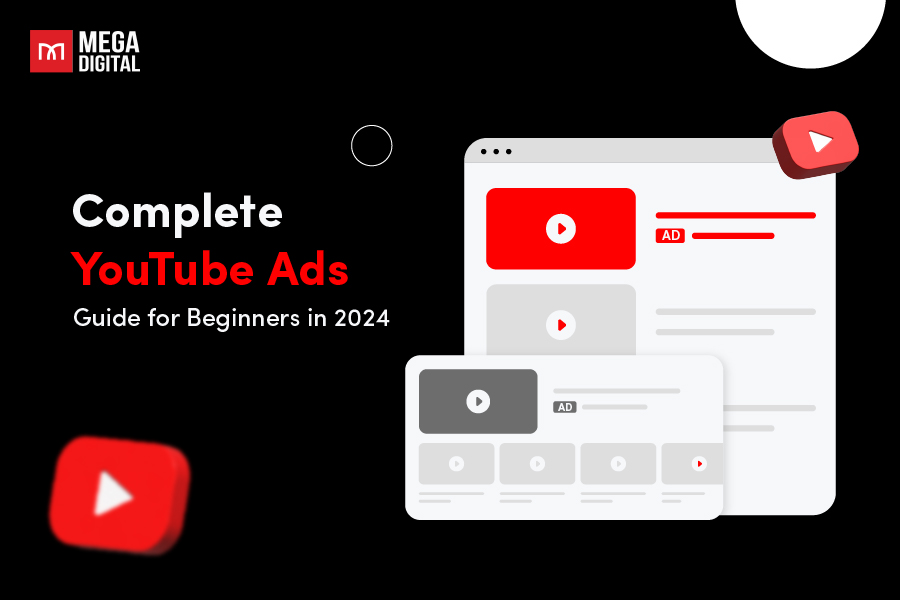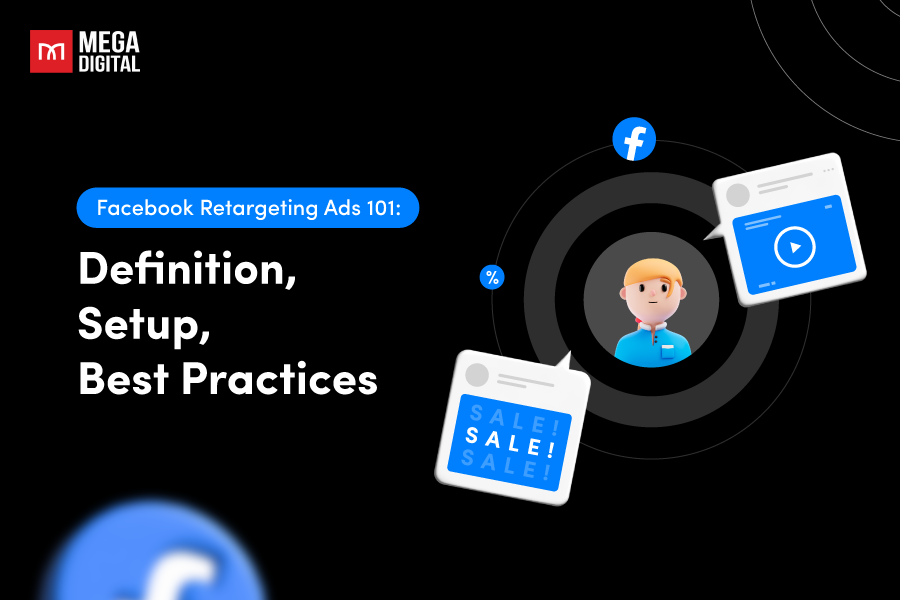Discover the essential elements of a Google Shopping campaign structure, including priority settings, ad group strategies, and product group segmentation. Dive into the top 6 performing campaign structures. Whether brand-specific campaigns, segmenting by product type, or using query sculpting techniques, these strategies offer valuable insights.
Elements of Google Shopping Campaign Structure
Every campaign should encompass multiple ad groups. Within your Shopping ads account, it’s essential to categorize your products into groups.
Many online sellers have a lot to do, and they don’t want to spend extra time setting up these groups and testing them. But if you want to beat your competition, you have to put in some extra work.
To begin, it’s essential to revisit the fundamentals. There are three key elements of campaign structure to consider:
- Priority options
- Ad groups
- Product groups
Now, let’s delve into each of these elements.
Priority options
In Google Shopping Campaigns, you can choose from three campaign priorities: High, medium, and low. These priorities play a role in your strategy. Although we’ll dive deeper into this later, here’s a basic idea to get you started.

High-priority campaigns are ideal for products like new arrivals, best-sellers, or items on clearance. These are the products you want to sell more than anything else.
Medium-priority campaigns work well for showcasing product categories, specific product lines, or targeting particular regions.
Low-priority campaigns serve as catch-all campaigns. They cover all your products or your entire store in a single campaign.
Ad groups
Just like in regular Google Ads, your Google Shopping campaigns also have ad groups. It’s a good idea to keep these groups well-organized. In other words, try not to put too many products in one group. This way, you can easily change how much you’re willing to pay for clicks or make other improvements.
For instance, let’s say you’re running a shopping campaign focused on a single category, like shoes. Within that, you can have separate ad groups for different types of shoes you sell, such as sneakers, sandals, or heels. These ad groups would appear in response to different searches, and you can fine-tune them individually.
Product groups
In each of your Google Shopping ad groups within a Shopping campaign, you’ll find product groups or smaller sets of your inventory. A Google Shopping campaign’s ad group can contain as many as 20,000 of these product groups. These groups consist of products that relate to the same Ad Group and share the same bidding strategy.
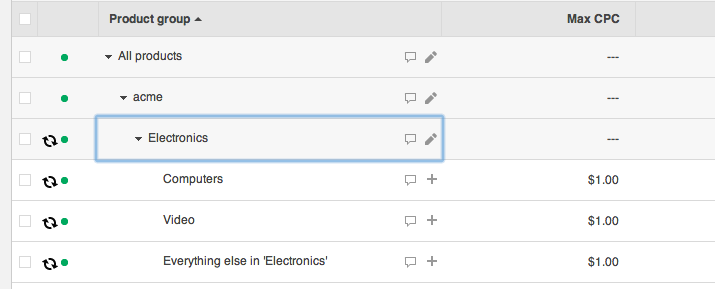
You can either group all your products together or break them down into up to 7 levels for more detailed organization. Google offers various filters you can apply to your Shopping Product Groups:
- Product type: Based on how you categorize your inventory.
- Category: Aligned with the category structure on your website or Google’s product categories.
- Item ID: Identified by the unique ID of each product.
- Custom labels: Created by you for up to 5 thematic labels.
- Brand: Sorted by the manufacturer of the product.
- Channel: Determined by the sales channel where the product is available.
- Condition: Classifies products based on their condition, such as new or used.
You have room for creativity, like splitting product groups based on profit margins and pricing. For example, using the shoe category mentioned earlier, you can create a straightforward illustration of all the elements we’ve discussed in a Google Shopping campaign.
Top 6 Google Shopping Campaign Structure Strategies
1. One campaign and one ad group
The most basic way to start a Shopping account is by creating one campaign, adding one Ad Group, and then segmenting your product groups.
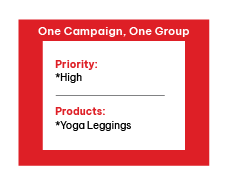
Advantages:
- Simple setup
- Requires less ongoing management
Disadvantages:
- Limited control over search queries through Shopping Ads negative keywords
- Difficult to increase bids for brand or high-intent terms without increasing generic clicks
- No control over search queries at the product level
- Some products may not receive exposure or clicks
- Challenging to manage poor-performing products without removing them from the Shopping feed
2. One campaign and numerous ad groups
Another basic approach in structuring Shopping campaigns involves setting up a single campaign but with multiple Ad Groups. For instance, consider the yoga legging business that now offers a range of sports leggings. In this case, you could create a single campaign encompassing various ad groups categorized by product types like yoga leggings, running leggings, short leggings, and so on.
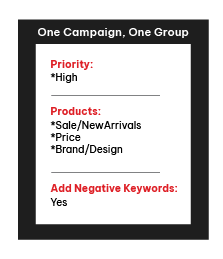
Alternatively, if you’re exclusively selling yoga leggings, you might organize groups around product attributes like price, design, popularity, and more. This structure offers clearer insights into the performance of different product types and allows for the use of distinct negative keywords for various groups.
Advantages:
- Simplified performance reporting and tracking for each product type.
- Improved targeting through the use of negative keywords.
Disadvantages:
Since it’s a single campaign, all ad groups draw from the same budget pool.
3. Two campaigns using campaign priorities
The concept behind using two separate campaigns is to gain greater control over the search terms for which your products appear. This is achieved through the use of campaign priority settings and negative keyword lists.
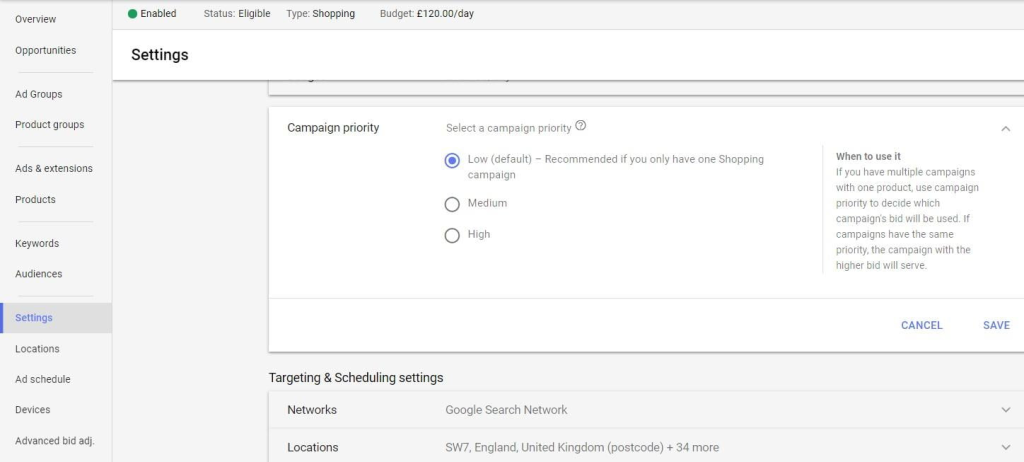
Advantages:
- Simple setup; create the first campaign and then duplicate and adjust priority settings.
- Increased control over bidding for high-intent terms like brand terms or specific converting queries.
Disadvantages:
- Managing twice as many campaigns (not a major issue).
- Ensuring neither campaign is budget-limited to prevent irrelevant queries.
- Inability to control search queries at the product SKU level.
- Segmenting products in one Ad Group within each campaign remains challenging.
- Some products may receive limited exposure or clicks due to product groupings.
- Managing poorly performing products is more challenging unless they are removed from the Shopping feed entirely.
4. Three campaigns with three ad groups
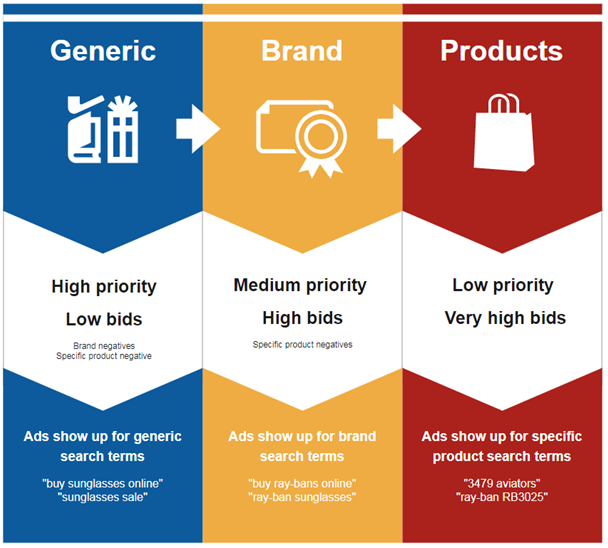
Advantages:
- Enhanced control over bidding for higher intent terms with three campaigns.
- Improved account profitability.
- The ability to set bid adjustments for devices, locations, and audiences based on term performance.
Disadvantages:
- Managing three times as many campaigns.
- Ensuring none of the campaigns becomes budget-limited, impacting query control.
- Challenges in segmenting products within one Ad Group in each campaign.
- Inability to control search queries at the product level.
- Some products may receive limited exposure or clicks due to groupings within a single Ad Group.
- Managing poorly performing products is more challenging unless they are removed from the Shopping feed entirely.
Multiple approaches can be used to set up a three-priority campaign structure, and we’ll delve into a few of them here:
Generic, Brand, Brand + Size
You can segment your keywords into three categories: generic terms, branded terms, and branded terms combined with high-intent attributes like size or product name.
Generic, Brand, Sale + Brand shopping campaign
This approach is quite similar to the one mentioned above. Creating a sale campaign allows you to increase bids on products that are on sale and likely to convert.
Shoppers are often drawn to great offers, so segmenting your keywords into generic terms, branded terms, and branded terms combined with high-intent attributes like size or product name can be beneficial.
Query Length: Short, Medium, Long
With this approach, your campaigns are structured to manage the length of search queries effectively.
This strategy can be complex. Additionally, you’ll need to analyze your historical Shopping data to identify which query lengths have higher or lower conversion rates. This data can be found in Google Analytics or processed using Excel.
Implementing this approach can be challenging unless you can automate the process of adding negative keywords to your lists. Keep in mind that there’s a limit to the number of shared library negative keyword lists, which is 20 lists with a maximum of 5000 negative keywords in each list.
5. Three campaigns and three groups using query sculpting
Addressing the challenge of limited keyword control in Google Shopping, this campaign strategy involves dividing campaigns by priority and leveraging search query patterns to enhance their performance.
Incorporate negative keywords into your Shopping campaigns to refine your ad targeting. This approach allows you to control where your ads won’t appear by excluding specific terms. In Shopping campaigns, you manage negative keywords through search term reports and add selections to your negative keyword lists.
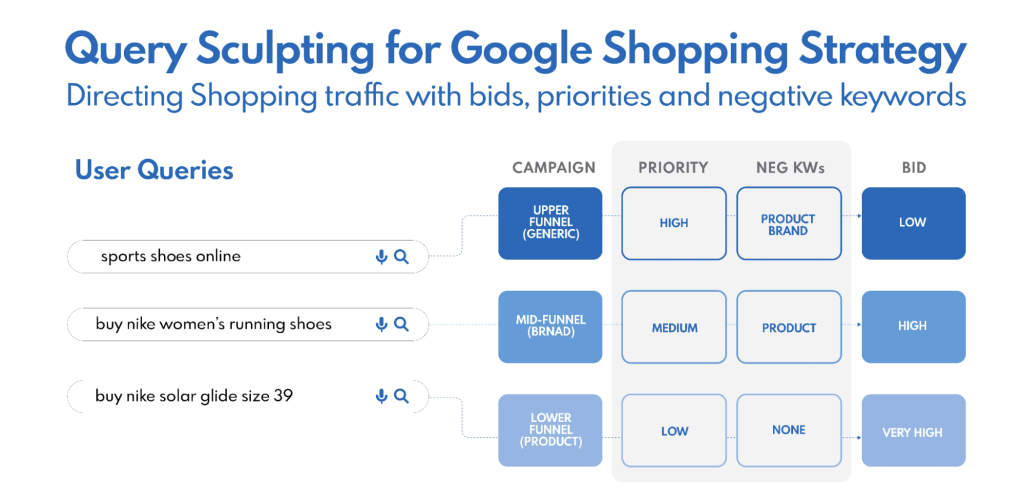
The three-tiered priority campaign structure involves creating three campaign types based on priority. You then use product exclusions and negative keywords to split the groups, indicating to Google which searches should be displayed for each campaign.
Advantages:
This approach offers better control over the search terms you bid on, allowing for improved ROIs through location, audience, and device bid adjustments based on negative keyword list performance.
Disadvantages:
It’s a complex structure that requires more time, monitoring, and testing. Grouping products in campaigns reduces performance control at the product level, and there’s a limit of 5,000 negative keywords for those with many products.
Three-Tiered Generic/Brand Priority
In the three-tiered priority campaign structure, you have three campaigns set at different priority levels. The high-priority campaign is for your top-selling or clearance items, the ones you want to push the most. The medium-priority campaign can include specific product groups, and the low-priority campaign encompasses all your products.
Imagine you sell shoes, socks, and bags online. With this structure, you use negative keywords to prevent brand search terms when using generic terms and vice versa. This ensures better control over when your ads appear, especially for generic search terms. For example:
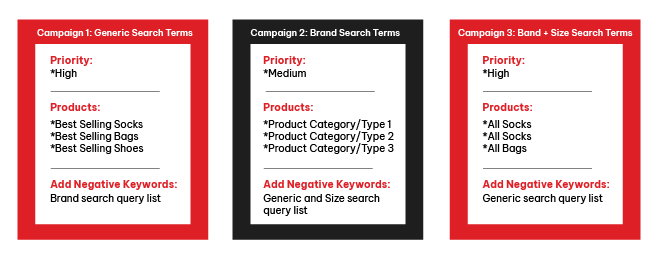
- In the high-priority campaign, imagine you want your Shopping ads to appear for general search terms like “laptop.” You would use a negative keyword list that contains specific brand-related keywords.
- For the medium-priority campaign, let’s say your goal is to target search queries related to a particular brand, like “Apple laptops.” In this case, you’d employ a negative keyword list that includes generic-related keywords and another one with size-related keywords.
- In the low-priority campaign, you might aim to capture brand and size-specific search queries, such as “Apple MacBook Air 13-inch.” You would use a negative keyword list that contains generic-related keywords to achieve this level of control over your ad visibility.
Three-Tiered By Query Length
This approach, although similar to the first example, involves adding negative keywords within each campaign to restrict search terms based on their length, determining when your Shopping ads should appear.
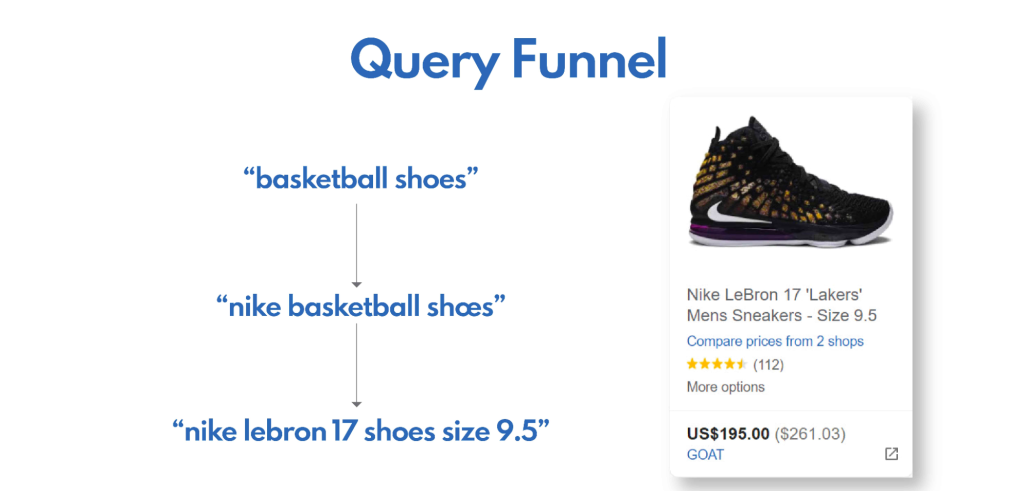
The main challenge here lies in the administrative work required. You’ll need to review the length of search queries, which can be found in your Search Queries Report in Google Analytics, and then incorporate them into your campaigns. We recommend considering this structure only when you observe significant differences in the performance of search query lengths. It’s worth noting that while effective, this structure can be quite demanding, especially for beginners.
6. Profit Margin approach
This approach involves organizing your campaigns by product categories based on profit margins. For instance, if you manufacture your own products, your profit margins are likely different from the products you resell.

Advantages:
- Provides more control over bidding for high-intent terms with three campaigns.
- Allows you to concentrate your budget and efforts on traffic that yields the best returns.
- Enhances the overall profitability of your account.
- Enables setting bid adjustments for devices, locations, and audiences based on the performance of different types of search terms.
Disadvantages:
- If you offer a wide range of products, you’ll need to create multiple sets of two or three campaign priority groupings for each product category.
- Must monitor budget limitations to prevent campaign constraints.
- Organizing products within one Ad Group in each campaign can be challenging.
- Unable to control search queries at the product SKU level.
- Some products may receive limited exposure or clicks due to groupings within a single Ad Group.
- Managing poor-performing products can be complex unless you remove them from the Shopping feed altogether.
You can expand this approach to include 6, 9, or 12 campaigns, further segmenting your products by the categories you sell.
Google Shopping campaign structure examples:
Campaign Set 1
- Campaign 1: Laptops – Generic
- Campaign 2: Laptops – Brand/Type
- Campaign 3: Laptops – Brand/Type SKU
Campaign Set 2
- Campaign 1: Smartphones – Generic
- Campaign 2: Smartphones – Brand/Type
- Campaign 3: Smartphones – Brand/Type SKU
If structuring your shopping campaign feels like a challenge, don’t worry – Mega Digital is here to assist. Moreover, our expertise lies in maximizing shopping campaigns to deliver exceptional ROI. Your success is our priority.
Using only one ad group disadvantages
Starting with one Ad Group in a Google Shopping campaign and breaking it down into smaller product groups based on attributes like Brand, Price, and Category is a solid strategy, especially for those new to Google Shopping.
The logic behind this approach involves initially setting up product group divisions and then refining them over time as you gather data on clicks and conversions. However, it’s worth noting that this approach has its limitations, in our view.
Bonus Google Shopping Campaign Structure Tips
We’ve covered some top Google Shopping campaign structure strategies for you, and now it’s time for some bonus tips:
Handle new changes of inventory category
No matter which campaign structure you opt for to maximize success, it’s crucial to maintain real-time synchronization of your product feeds. This ensures ongoing profitability and the proper categorization of inventory changes. For example, if you’ve meticulously organized your Shopping campaign for pants, but you introduce a new product in a different category, that new item might end up in your general ‘catch-all’ campaign by default. While this isn’t a major concern for sporadic additions, frequent inventory changes can quickly throw your well-structured campaigns out of sync.
To stay on top of this, promptly update the category lists within your Shopping campaigns or establish a dedicated campaign for the new category. This should be part of your product launch and marketing checklist to maintain campaign effectiveness.
Deal with a limited budget
If your budget is tight and you lack the resources for complex campaign structures, begin by narrowing down the number of products in your Shopping campaigns. You can achieve this by filtering your campaign to include only high-impression shared products or by grouping them based on popularity, as indicated by your site’s sales data.
In essence, keep your campaigns small, focusing on the products that offer the best ROI within your constrained budget. As your sales grow, gradually allocate more budget to top-performing products or introduce new items to your campaigns. You can start with as few as 3-5 products, structured like this, for example:
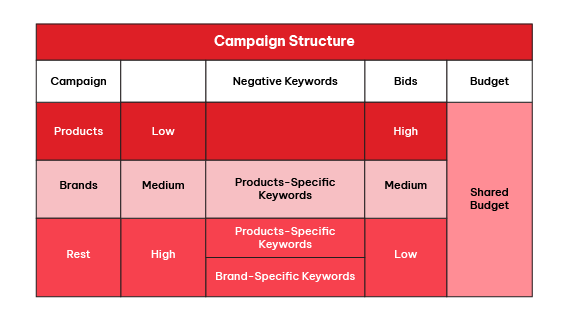
>>> Read more: Top 8 Ways to Optimize Google Shopping Campaign for Starters
Final word
In summary, mastering Google Shopping campaign structure involves balancing elements like campaign priorities, ad groups, and product segmentation. The ideal strategy hinges on your business goals, budget, and product volume. Flexibility is key to adapting to market shifts and inventory changes. With the right structure, you can optimize Google Shopping to boost online sales and ROI.
>>> Read more: Google Shopping Ads Benchmarks: CPC, CTR, Budget, and More







